Endogenous hepcidin and its agonist mediate resistance to selected infections by clearing non-transferrin-bound iron
- PMID: 28465342
- PMCID: PMC5520472
- DOI: 10.1182/blood-2017-03-772715
Endogenous hepcidin and its agonist mediate resistance to selected infections by clearing non-transferrin-bound iron
Abstract
The iron-regulatory hormone hepcidin is induced early in infection, causing iron sequestration in macrophages and decreased plasma iron; this is proposed to limit the replication of extracellular microbes, but could also promote infection with macrophage-tropic pathogens. The mechanisms by which hepcidin and hypoferremia modulate host defense, and the spectrum of microbes affected, are poorly understood. Using mouse models, we show that hepcidin was selectively protective against siderophilic extracellular pathogens (Yersinia enterocolitica O9) by controlling non-transferrin-bound iron (NTBI) rather than iron-transferrin concentration. NTBI promoted the rapid growth of siderophilic but not nonsiderophilic bacteria in mice with either genetic or iatrogenic iron overload and in human plasma. Hepcidin or iron loading did not affect other key components of innate immunity, did not indiscriminately promote intracellular infections (Mycobacterium tuberculosis), and had no effect on extracellular nonsiderophilic Y enterocolitica O8 or Staphylococcus aureus Hepcidin analogs may be useful for treatment of siderophilic infections.
© 2017 by The American Society of Hematology.
Figures
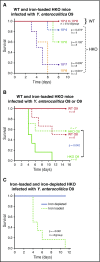
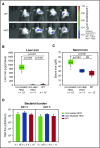

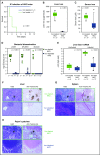
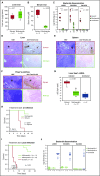

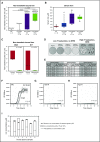
Comment in
-
Ironing out the role of hepcidin in infection.Blood. 2017 Jul 20;130(3):233-234. doi: 10.1182/blood-2017-05-783688. Blood. 2017. PMID: 28729331 No abstract available.
Similar articles
-
Hepcidin Protects against Lethal Escherichia coli Sepsis in Mice Inoculated with Isolates from Septic Patients.Infect Immun. 2018 Jun 21;86(7):e00253-18. doi: 10.1128/IAI.00253-18. Print 2018 Jul. Infect Immun. 2018. PMID: 29735522 Free PMC article.
-
Hepcidin-induced hypoferremia is a critical host defense mechanism against the siderophilic bacterium Vibrio vulnificus.Cell Host Microbe. 2015 Jan 14;17(1):47-57. doi: 10.1016/j.chom.2014.12.001. Cell Host Microbe. 2015. PMID: 25590758 Free PMC article.
-
Expression and localization of hepcidin in macrophages: a role in host defense against tuberculosis.J Leukoc Biol. 2007 Oct;82(4):934-45. doi: 10.1189/jlb.0407216. Epub 2007 Jul 3. J Leukoc Biol. 2007. PMID: 17609338
-
Modulation of hepcidin as therapy for primary and secondary iron overload disorders: preclinical models and approaches.Hematol Oncol Clin North Am. 2014 Apr;28(2):387-401. doi: 10.1016/j.hoc.2013.11.004. Epub 2014 Jan 18. Hematol Oncol Clin North Am. 2014. PMID: 24589273 Free PMC article. Review.
-
The pathophysiology and pharmacology of hepcidin.Trends Pharmacol Sci. 2014 Mar;35(3):155-61. doi: 10.1016/j.tips.2014.01.004. Epub 2014 Feb 17. Trends Pharmacol Sci. 2014. PMID: 24552640 Free PMC article. Review.
Cited by
-
Iron homeostasis and plant immune responses: Recent insights and translational implications.J Biol Chem. 2020 Sep 25;295(39):13444-13457. doi: 10.1074/jbc.REV120.010856. Epub 2020 Jul 30. J Biol Chem. 2020. PMID: 32732287 Free PMC article. Review.
-
Iron Administration, Infection, and Anemia Management in CKD: Untangling the Effects of Intravenous Iron Therapy on Immunity and Infection Risk.Kidney Med. 2020 Mar 27;2(3):341-353. doi: 10.1016/j.xkme.2020.01.006. eCollection 2020 May-Jun. Kidney Med. 2020. PMID: 32734254 Free PMC article. Review.
-
The role of Vibrio vulnificus virulence factors and regulators in its infection-induced sepsis.Folia Microbiol (Praha). 2020 Apr;65(2):265-274. doi: 10.1007/s12223-019-00763-7. Epub 2019 Dec 16. Folia Microbiol (Praha). 2020. PMID: 31840198 Review.
-
Biomarkers for iron metabolism among patients hospitalized with community-acquired pneumonia caused by infection with SARS-CoV-2, bacteria, and influenza.APMIS. 2022 Sep;130(9):590-596. doi: 10.1111/apm.13259. Epub 2022 Jul 18. APMIS. 2022. PMID: 35751642 Free PMC article.
-
Iron metabolism imbalance at the time of listing increases overall and infectious mortality after liver transplantation.World J Gastroenterol. 2020 Apr 28;26(16):1938-1949. doi: 10.3748/wjg.v26.i16.1938. World J Gastroenterol. 2020. PMID: 32390704 Free PMC article.
References
-
- Nemeth E, Ganz T. Regulation of iron metabolism by hepcidin. Annu Rev Nutr. 2006;26:323-342. - PubMed
-
- Christopher GW. Escherichia coli bacteremia, meningitis, and hemochromatosis. Arch Intern Med. 1985;145(10):1908. - PubMed
-
- Gerhard GS, Levin KA, Price Goldstein J, Wojnar MM, Chorney MJ, Belchis DA. Vibrio vulnificus septicemia in a patient with the hemochromatosis HFE C282Y mutation. Arch Pathol Lab Med. 2001;125(8):1107-1109. - PubMed
-
- Manso C, Rivas I, Peraire J, Vidal F, Richart C. Fatal Listeria meningitis, endocarditis and pericarditis in a patient with haemochromatosis. Scand J Infect Dis. 1997;29(3):308-309. - PubMed
MeSH terms
Substances
Grants and funding
LinkOut - more resources
Full Text Sources
Other Literature Sources
Medical
Molecular Biology Databases

